We have worked quite a bit with the Supermicro A1SAi-2750F over the past few weeks. First we did an initial performance thread in the forums. We also published power consumption and Intel Atom C2750 performance numbers based on the platform. Certainly this has led to much experience with the platform and we felt is was prudent to do a review based on some longer-term perspectives. For those wondering, the Intel Atom C2750 is still supply constrained which will hopefully clear up in the near future. This class of computing platform is set to be a major game changer. The quick summary is that the Supermicro A1SAi-2750F provides similar performance to the lower end of the Intel Xeon E3-1200 series in many applications yet uses less than half of the power.
Test Configurations
We had two main test configurations which is not something we always get to do. Due to the SoC design, the Intel Atom C2750 platform is very compact and requires very little to get up and running. We have two Supermicro A1SAi-2750F Avoton test platforms that we have been hammering for the past few weeks in different configurations. Here are the two configurations:
Test Configuration #1 (used for power testing and performance testing):
- Motherboard/ CPU: Supermicro A1SAi-2750F with Intel C2750 Avoton 8C/ 8T SoC
- SSD: Intel S3700 100GB SSD
- Memory: 32GB (4x 8GB) 1600MHz 1.35v Kingston KVR16LSE11/8 DDR3 SODIMMs
- OS: Ubuntu 13.10 daily (20 September 2013)
- Power supply: 1U 200w 80+ Gold PWS-203-1H
Test Configuration #2:
- Motherboard/ CPU: Supermicro A1SAi-2750F with Intel C2750 Avoton 8C/ 8T SoC
- SSD: Intel S3700 100GB SSD
- Memory: 8GB (2x 4GB) 1600MHz 1.35v DDR3 Kingston KVR16LSE11/4 SODIMMs
- OS: Ubuntu 13.10 daily (20 September 2013)
- Power supply: 1U 200w 80+ Gold PWS-203-1H
We also utilized our standard array of PCIe add-on cards along with Seagate and Western Digital spindle drives to text maximum configurations, but those were our two main test beds.
The Supermicro A1SAi-2750F
The Supermciro A1SAi-2750F is a very compact server motherboard. It utilizes the mini ITX form factor. That means it is approximately 6.75″ by 6.75″ and makes most standard ATX and larger motherboards look enormous in comparison. We also removed the heatsink to see the Intel Atom C2750 SoC package. Overall, this is a densely packed motherboard. One will also notice that there is a major difference between our samples and the initial product shots on Supermicro’s site.
The Marvell Ethernet transceiver sits just behind the quad Gigabit Ethernet ports. It is one of the key components to get the Avoton / Rangeley quad Intel i354 NIC working. We have certainly heard that it is a quite expensive part. One very interesting note here is that the Marvell chip looks fairly large compared to the Avoton package.
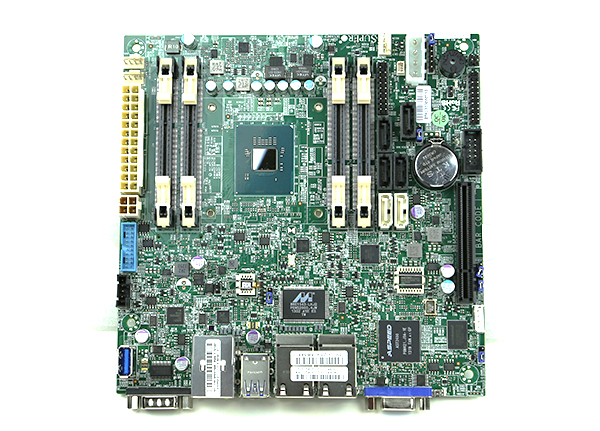
Since the Avoton platform is very well integrated, this small mITX platform comes pre-installed with virtually everything needed for a working system. One major required component are the DDR3 SODIMMs that the motherboard takes. Kingston sent eight of their 1.35v low power 8GB DDR3-1600MHz ECC memory modules for our testing. One thing that we certainly noticed was that our ECC SODIMMs worked with the motherboard while standard non-ECC SODIMMs were causing issues. The bottom line here is to check manufacturer compatibility lists and use ECC SODIMMs with these server platforms.
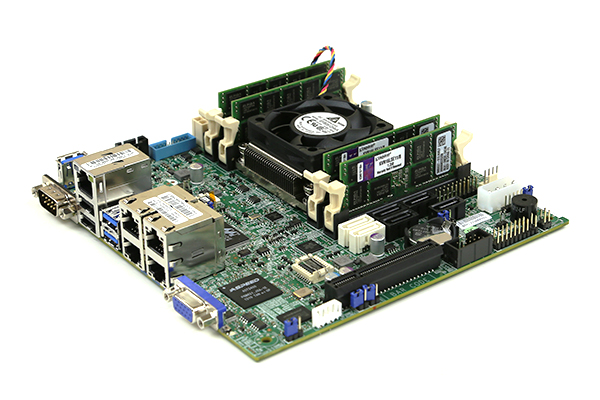
The top of the Supermicro A1SAi-2750F shows some interesting features. There is a standard 24-pin ATX power connection plus a 4-pin CPU power connector. Other very interesting features are both a front panel USB 3.0 connector along with an internal Type-A USB 3.0 header. This is a major upgrade to previous generation Atom (and even Xeon) platforms as it allows for fast USB 3.0 sticks to be added inside the server chassis. Perfect for boot images.
The CPU fan’s power cable was just long enough to fit around the top SODIMM slots.
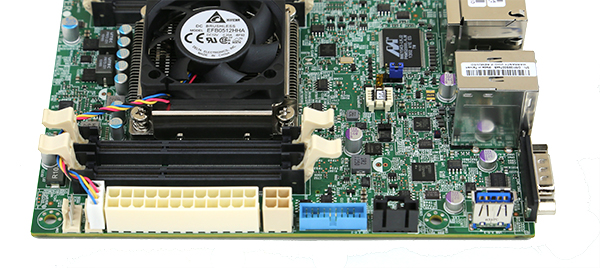
The bottom side of the motherboard had several interesting features. We see the ASpeed AST2400 chip displayed prominently which runs the BMC for IPMI 2.0 functionality.
The two white 7-pin SATA ports are SATA III 6.0gbps ports while the four black 7-pin SATA II ports provide additional storage flexibility. Overall, six onboard ports is ample for many applications. One other interesting feature is a 4-pin molex connector so that a hard drive can be powered directly from the motherboard. In theory, one can have an entire system powered solely by the ATX power connector.
As for PCIe connectivity the Supermicro A1SAi-2750F has a PCIe x8 slot. This gives the platform a lot of flexibility in terms of being able to add additional controllers. We tested using both the newer LSI 9300-4i4e card, 9207-8i, and 9240-8i HBA/ RAID cards and they worked fine. Moving to a 16 port card would provide 22 drives worth of connectivity along with the platform’s existing quad Ethernet solution. We also utilized our Mellanox QDR and FDR Infiniband cards in the slot successfully. Unlike the previous generation Atom S1260, the new Avoton / Rangeley platform is much more robust and having an extra PCIe x8 slot adds much flexibility to the platform.
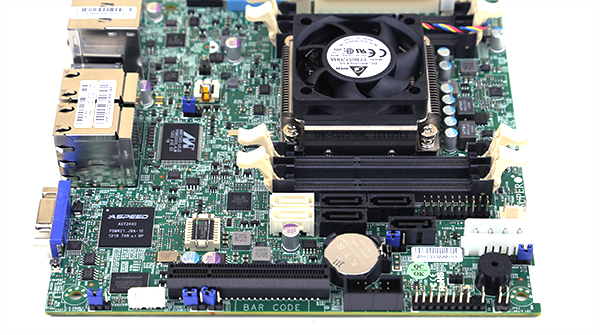
The rear I/O panel follows the standard Supermicro X9 and X10 series I/O panel design. One can, for example, see a similar layout in our Supermicro X10SL7-F review. There are legacy VGA and serial ports. Peripherals can be connected using two USB 3.0 and two USB 2.0 ports on the rear panel.
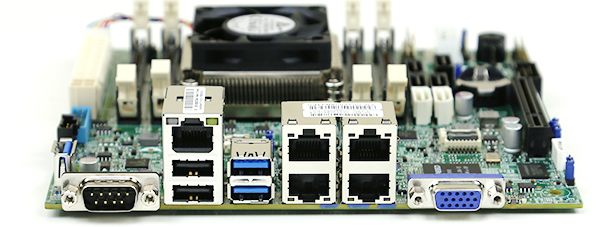
Networking is provided by a dedicated IPMI port (above the USB stack). The quad Intel Ethernet ports can be found on the rear panel as well. The Intel Atom C2750 has a quad port Intel i354 gigabit controller built-in. The built-in Avoton MAC is a 4x 2.5Gig Ethernet design so this is essentially a built-in quad port NIC. From those ports the general decision manufacturers must make is to connect them directly to a chassis switch chip or use a Marvell based PHY. Supermicro utilizes the Marvell controller as we saw in earlier board shots.
Software and Management
Supermicro’s IPMI and KVM-over-IP as described a few times on this site, allows for a lot of deployment flexibility. Things such as fan speeds, chassis intrusion sensors, thermal sensors, and etc. can be monitored remotely. Alerts can be setup to notify the admins of issues. Beyond this, the functionality also allows for remote power control. You can do remote power up, power down, and reset of the server in the event that it becomes unresponsive. In fact, the test system has never had a keyboard, mouse, CD/DVD ROM, or monitor hooked up to it, even after multiple BIOS tweaks and operating system/ hypervisor installations.
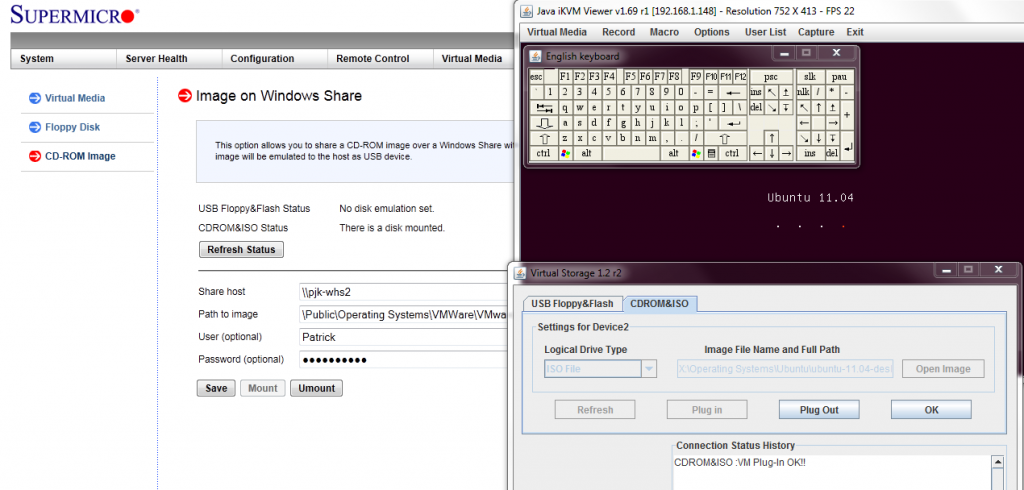
Another important feature is the ability to remotely mount CD images and floppy images to the machine over the dedicated management Ethernet controller. This keeps maintenance traffic off of the primary Intel NICs. At the same time it removes the need for an optical disk to be connected to the Supermicro motherboard. Combined with the onboard Type-A USB 3.0 header, mounting OS installation or recovery images remotely is a very simple affair.
Performance
The Intel Atom C2750 recently showed itself to be a solid performer. Here is a great example from our recent performance comparison using the Supermicro A1SAi-2750F platform:
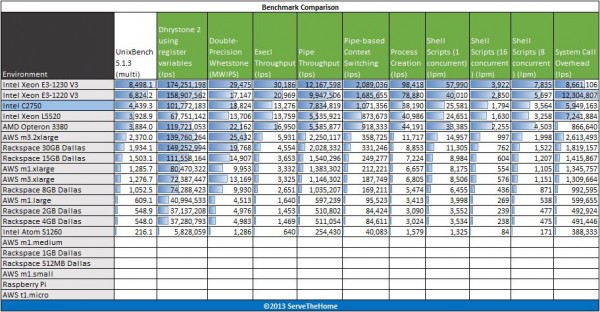
Click the link for a more complete comparison, but the UnixBench 5.1.3 results show a significant increase over previous generation Intel Atom architectures.
Power Consumption
We did a full piece on the Intel Atom C2750 Avoton power consumption. For a quick reference, here is a key chart showing the difference between the options. One major item to note, our load included full network card loads. For other platforms to have quad gigabit Ethernet ports an additional 2-port NIC would be required, adding another 6w or more to the load figures.
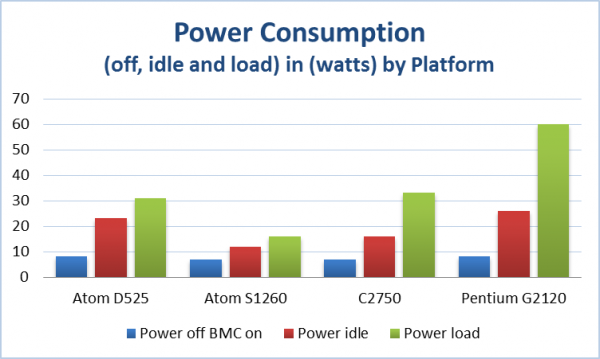
Click on the image to read more, but suffice to say the Intel C2750 found on the Supermicro A1SAi-2750F is a game changer.
Conclusion – This is a game changer!
Overall the Supermicro A1SAi-2750F is an awesome product for those looking at a microserver sized deployment. The performance in many workloads is about 50-60% of a new Intel Xeon E3-1200 series part but the power consumption is likewise less than half, even with all four gigabit Ethernet ports working under full load. We already showed how to get VMware ESXi 5.5 working with the unit and there is no reason with the quad Intel NICs that this motherboard cannot run a virtual pfsense, Vayatta or other appliance along with a storage server appliance (without VT-d on the platform) and other application specific appliances. The power consumption figures and platform capabilities strongly support this use case.
Further, there are times when simply having many nodes helps. For example, if one wants to build a redundant architecture, but does not necessarily need a maximum amount of processor power, this is a great motherboard. One simple example here is with web serving where the Intel Atom C2750 will shine. In a 1A / U (at 120v) for example, the Avoton platform can fit three full nodes with SSDs and a low power switch. This allows for small clusters of nodes with sufficient memory, performance and networking capabilities to replace a typical Intel Xeon E3-1200 system. With the Atom S1260 the performance difference and lack of memory did not allow these platforms to take this role. The Atom C2750 is fundamentally a more robust architecture.
A final great use case for these, and potentially the Rangeley variant (the Supermicro A1SRi-2758F) is as low end firewall/ network appliances. For example, the STH architecture has dual pfsense nodes. Each node has a single Intel Xeon L5520, 24GB of RAM, a SSD, two onboard NICs and an add-in dual port gigabit controller. One gigabit ports on each is used for the uplink, one for the heartbeat with the mirror node, and one NIC for each switch. These Avoton/ Ragneley platforms use significantly less than half of the power and have about the same performance (and much faster AES speeds due to AES-NI) as the currently used nodes.
At the end of the day, the Supermicro A1SAi-2750F and similar variants are a major shift in computing. The idea of readily accessible, low power, high core count architectures with solid networking and decent memory configurations is here. Bottom line: this is a game changer in terms of performance/ watt/ capability.





Two minor minor notes- the total ram for the second config should be 8GB not 32GB and the form factor is mini-ITX, not micro-ITX…
Why are these so expensive?!?! $700 is rediculous. I thought they were supposed to be around $400-$450 USD?
Saw this on Facebook. We would totally use those clusters. We could build a CDN with these and Crucial M500 960gb drives. Would cost nothing to colo if you could put 3 + switch + 6x 2.5″ drives in a 1U.
Hello, am seeing these for 375USD with availabilty in US.. At this price is a real consideration to change a build I am planning..Regards PGH
I like the fact that you guys have been reviewing this stuff for like a month while there is almost no other information on Avoton.
Kudos! Certainly more information than anyone else at this point. Keep up the good work
Noticed this setup has an ASPEED ast2400. Would be curious to see a real world comparison of capabilities between it and a Matrox G200eW. Also curious if this setup would make a good media center PC with a 1080P display or is the ast2400 still to limited.
Greg, I have been looking at the same comparison. The biggest thing I have seen thus far is that the AST2400 Supports a USB 2.0 host + 2x USB 1.1. The AST2300 supports 1x USB 1.1
Certainly video output speed is not anything amazing. I think for a HTPC I would still want HDMI out.
If you believe the sparse documentation available, the 4-pin power connector next to the ATX power connector is not a standard CPU power connector. It is 12V input thought as an alternative to a ATX supply. That is also the reason they included a 4-pin molex.
This board would be better for NAS with more SATA ports, another PCIE port or a mini PCIE/mini sata slot on the board. I think there’s room for it. :-(
Thanks for the review.
Wish the review had some real world benches.
Hi,
it is posible testing some benchmark with discrete graphics card AMD or Nvidia?
Regards
Tralalak
I really really wish these had Vt-d and SRIOV support.
Then they would make for an awesome virtualization platform!!
A bit hard on this platform unless one uses a PCIe x8 to x16 riser. What tests are you specifically thinking about? I am unsure what the use case would be for this.
I saw that too but have not found the power supply that works with this. Interestingly enough, the 4-pin power connector is the same one used for normal 4-pin CPU power connections.
I want build my world’s “Personal Gaming a Home Entertainment Console” on the Intel Atom C2750 8-Core Avoton Processor /Supermicro A1SAi-2750F Mini-ITX board or ASRock C2750D4I Mini-ITX board/ :-)
Now I have VIA EPIA M920-12Q Mini-ITX with VIA QuadCore L4700E 1.2GHz with discrete graphics card etc. and I can play Batlefield 3 MP, or F1 2012 in HIGH details 1080p etc. (on the youtube is my some videos) End of course Avoton C2750 is more powerful.
May be enough only one 3DMark and one MultiThreaded game. This is only for the possibility this 8-core Atom platform “Yes, we can!”
For your case, I’d highly recommend a mini – iTX Haswell platform over the avoton.
I dont want the Haswell. Haswell have every other customer.
Intel Atom 8-core processor (open “Personal Gaming a Home Entertainment Console”) vs. AMD Jaguar 8-core processor (PS4, Xbox One) that is my Point of View.
“Haswell have every other customer.” is a pretty silly reason not to use it.
It’s the best solution for your problem.
An i7-4770K is guaranteed to destroy the avoton, or the Jaguar, even if 8-threaded application
Maybe he just wants to be different and doesn’t really care about performance as much?
Totally agree. These are not for gaming.
OMG. I know that Haswell is more powerful than Atom Silvermount. And what? I want 8-core Atom Silvermount processor with max TDP 20W.
AMD Jaguar 8-core processor is also not for gaming and Sony and Microsoft have gaming console PS4 and Xbox One. Where is Haswell in gaming console?
Anyway. I just only ask if Mr. Kennedy can tested. If not so ok. When will Supermicro A1SAi-2750F Mini-ITX board or ASRock C2750D4I Mini-ITX board available in EU so I will prepare this open “Personal Gaming a Home Entertainment Console” alone.
Any word on availability of these boards? I’ve seen them around at a few e-tailers I’ve never heard of and was hoping some more major players would start stalking them soon.
Totally agree that it would be an awesome thing to try, paired with a passive gpu in a convection case so its totally quiet. Ofcourse it would be eaten by a deskop i3-5 but thats not the point.Its already just cool to see how it would compare
I too really wished these new Atoms could do VT-d. I want to replace my old desktop used as a server and it too cannot do VT-d. It’s built with ESXi 5 and consumes 120w idle. Part of that power is used by 10 hdds that are never spinned down because the VMs don’t have control over the disks.
Now I’m faced with 3 choices:
1 – Buy 2 new Atoms system, one would be a iSCSI target and the other would be the consumer of those targets.
2 – Buy a low power Xeon that does VT-d
3 – Buy only one Atom system and run it as I do now, with disks running all the time.
Which would you do?
One don’t have to use a PC powersupply, one can feed 12V via this plug from an external powersupply.
A very useful solution if one have a local 12V system home.
Do it fit a 1U rack if one change the fan to a “blower” ?
I want this!
These are amazing little systems considering they are Atoms, just replaced my X3380 NAS mobo with one of these, and upgraded to W2K12 R2 in the process. Did try hunting around but couldn’t find one available for less the $699.00, but from a performance perspective on a NAS, it seems to be worth it so far.
It does look rather lonely though in my 2U 12 drive case though!
One question though, how do you get the Supermicro IPMI LAN to work…..this seems to be a lot more difficult than it should be….IPMI set to DHCP but still no joy….I think it is related to an empty MAC address, but I can’t seem to set this (not from within W212 anyway)….thoughts?
Supermicro propose, on their website, an uATX version with two pci-e (one 8x and one 4x) : A1SAM-2750F
and standard memory DIMM.
Did the CPU fan used in your setup come with the board? I recently got an A1SRi-2758F which came with a passive heatsink only. If you added it yourself, which one did you use?
Hi Rick,
Mine came with the active cooler. I will ask about this though.
Regards,
Patrick
…ecc so-dimm?
@Tralalak @Patrick Kennedy
Here is a 3DMARK benchmark of the A1SAI-2750 running in a 1u Supermicro CSE-504-203B Case, with the Standard Supermicro Rise RSC-RR1U-E8 fitted with a Asus Nvidia Geforce GT 630 2GB Silent 2X 8GB Kingston Value Ram ECC SO-DIMM 1.35V Ram a Samsung 830 Pro 250GB SSD & Hitachi 4TB Drive also have 2 of the 4pin PWM Fans Fitted
See http://www.3dmark.com/3dm/3673258
GPU Example http://www.amazon.co.uk/GeForce-Graphics-Express-2560×1600-Cooling/dp/B00D8QAQ2U/ref=sr_1_2?ie=UTF8&qid=1406744708&sr=8-2&keywords=nvidia+geforce+gt+630+2gb
it sadly is only DDR3 Ram based, so it is not the fastest in the block and to fit it in the case, you need to disconnect the vga from the backplane of the gpu card slot it in, then reattach the vga connector but it’s possible as its only connected via a ribbon cable, but please not that i do not recommend this setup because sadly the 200W PSU as supplied with the CSE-504-203B is only 20pin 200W and it is not powerful enough to make the system stable
and your usb3 will shut down, and the gpu card can have random crashes, i confirmed it was a power issue after RMAing the first board believed to be faulty and the replacement does the same so i tested with a Desktop 500W 24pin psu and problems were solved
so i am going to use this board as my router build running VMware EXSI & pfsence and a few other services which is fine, and i have opted togo for a bigger case Supermicro CSE-512F-441B with a 440W Platinum rated powersupply which will be more than enough to drive the A1SAM-2750 board i have to fit that case, so that is probally the build i would go with if you want to game on that platform also the A1SAM-2750 has a open ended x8 PCI-E slot so if your fitting in a 4U / Tower then you can run a x16 card in x8 with out the need for a special x8 card and get better gaming performance i will bench it, with my Asus R9 270X Direct CUII Top 2GB of cause that card wont fit in a 1u but it is just to test the GPU Performance
Hope that helps to clear up some of your questions :)
Beyre83
Hi Patrick,
Were you able to find out which fan is that? I am looking for a fan for CPU on A1SRI-2558F-O.
thanks,
Haroon